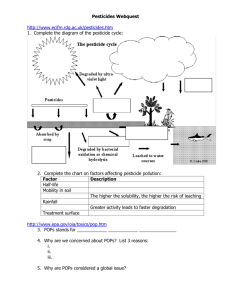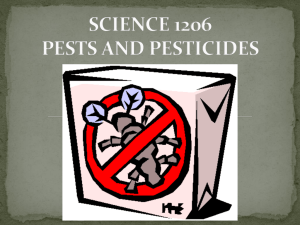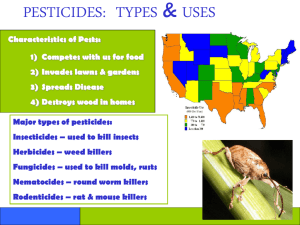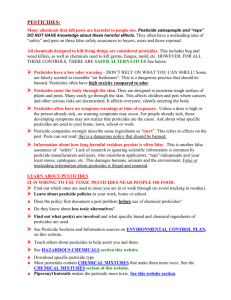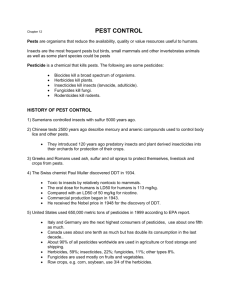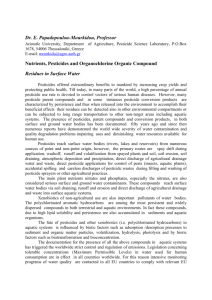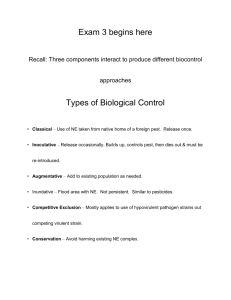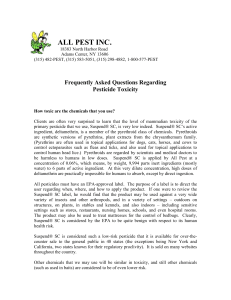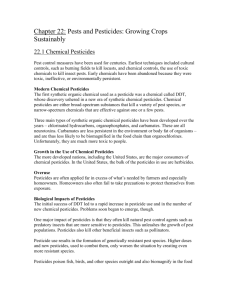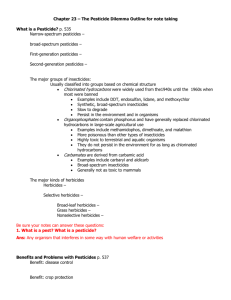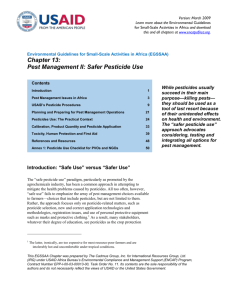pest Management Study Guide
advertisement
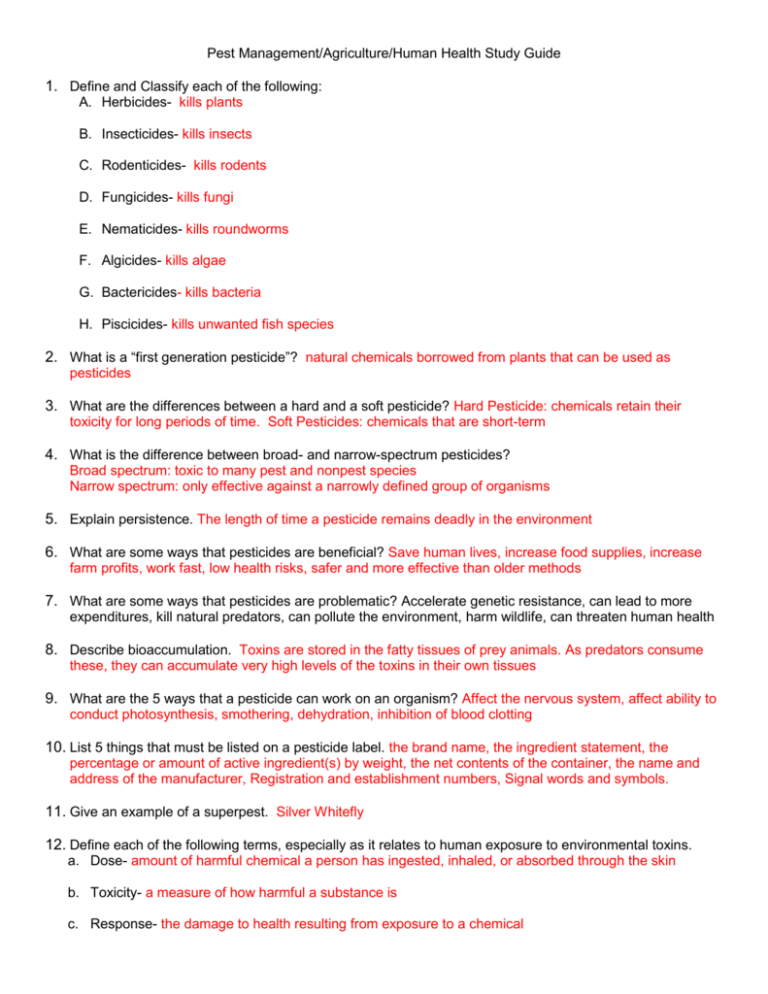
Pest Management/Agriculture/Human Health Study Guide 1. Define and Classify each of the following: A. Herbicides- kills plants B. Insecticides- kills insects C. Rodenticides- kills rodents D. Fungicides- kills fungi E. Nematicides- kills roundworms F. Algicides- kills algae G. Bactericides- kills bacteria H. Piscicides- kills unwanted fish species 2. What is a “first generation pesticide”? natural chemicals borrowed from plants that can be used as pesticides 3. What are the differences between a hard and a soft pesticide? Hard Pesticide: chemicals retain their toxicity for long periods of time. Soft Pesticides: chemicals that are short-term 4. What is the difference between broad- and narrow-spectrum pesticides? Broad spectrum: toxic to many pest and nonpest species Narrow spectrum: only effective against a narrowly defined group of organisms 5. Explain persistence. The length of time a pesticide remains deadly in the environment 6. What are some ways that pesticides are beneficial? Save human lives, increase food supplies, increase farm profits, work fast, low health risks, safer and more effective than older methods 7. What are some ways that pesticides are problematic? Accelerate genetic resistance, can lead to more expenditures, kill natural predators, can pollute the environment, harm wildlife, can threaten human health 8. Describe bioaccumulation. Toxins are stored in the fatty tissues of prey animals. As predators consume these, they can accumulate very high levels of the toxins in their own tissues 9. What are the 5 ways that a pesticide can work on an organism? Affect the nervous system, affect ability to conduct photosynthesis, smothering, dehydration, inhibition of blood clotting 10. List 5 things that must be listed on a pesticide label. the brand name, the ingredient statement, the percentage or amount of active ingredient(s) by weight, the net contents of the container, the name and address of the manufacturer, Registration and establishment numbers, Signal words and symbols. 11. Give an example of a superpest. Silver Whitefly 12. Define each of the following terms, especially as it relates to human exposure to environmental toxins. a. Dose- amount of harmful chemical a person has ingested, inhaled, or absorbed through the skin b. Toxicity- a measure of how harmful a substance is c. Response- the damage to health resulting from exposure to a chemical d. Chronic- permanent or long-lasting effect of exposure to a single dose or low-level exposure e. Acute- immediate or rapid harmful reaction to an exposure 13. What is the greatest risk factor for premature death in the United States? Poverty 14. Explain LD-50. Median Lethal Dose: the measured dose of a toxin that can kill 50% of the animals in a test population within a set time period 15. Explain the following laws: a. FIFRA- Federal Insecticide, Fungicide and Rodenticide Act (1947, 1972); EPA evaluation of health risks from pesticides already in use; States what must be on a pesticide label & requires registration of all pesticides b. FFDCA- Federal Food, Drug, and Cosmetic Act, strengthened in 1996, Sets pesticide tolerance levels c. FQPA- Food Quality Protection Act – requires EPA to reduce allowed levels of pesticide in food by a factor of 10 when information is inadequate on possible harmful effects on children. d. Label Protection Act – part of FIFRA, requires specific information on all labels of toxic chemicals 16. Describe Integrated Pest Management. Crop and Pests are evaluated as part of an ecological system. IPM uses a combination of biological controls, cultivation methods, and chemical tools and techniques 17. Give an example of using a predator to take care of a pest species. Ladybugs used to eat aphids 18. Name several alternatives to pesticides. Fool the pests, provide homes for pest enemies, implant genetic resistance, bring in natural enemies, use insect perfumes, use insect hormones 19. What is food security and what is the root cause of food insecurity? Food security means every person has daily access to nutritious food Food insecurity’s root causes are poverty, political upheaval, corruption, and war 20. Which continent has the largest drop in per capita food production? Africa 21. What issues does being undernourished cause? Mental retardation, stunted growth, death 22. What issues does being over nourished cause? Lower life expectancy, greater susceptibility to disease and illness, lower productivity and life quality 23. What is the difference between an epidemic and a pandemic? Epidemic: large scale disease outbreak in an area or country Pandemic: a global epidemic (AIDS) 24. What is industrialized agriculture? Uses heavy equipment and larger amounts of financial capital, fossil fuel, water, commercial fertilizers and pesticides to produce a single crop 25. What is industrialized agriculture’s major goal? To increase yield- the amount of food produced per unit of land 26. How much energy is used to produce food in industrialized agriculture? 10 units of non-renewable fossil fuel energy are used to put 1 unit of food on the table 27. What is traditional agriculture? Either subsistence farming (growing only for self) or intensive farming (uses human and animal labor, fertilizers, and water for higher yields) 28. What happened during the first green revolution? The second green revolution? First Green Revolution: farmers planted monocultures with high yields and used multi-cropping (several crops per year); grain production grew three-fold, and food production went up 31% Second Green Revolution: Genetic engineering is used to reformulate crop plants for specific climates, soils, and to withstand specific pests or other diseases 29. What happened during the first gene revolution? The second gene revolution? 1st Gene Revolution: Artificial selection was used to choose the best plants or animals to use for reproduction 2nd Gene Revolution: Genetic engineering is used to improve stock 30. Give advantaqes and disadvantages of feedlots. Advantages: increased meat production, higher profits, less land use, reduced land erosion huge amounts of animal waste Disadvantages: uses lots of grain, water and energy, produces 31. What happened in Borneo? A pesticide was used to kill mosquitoes; it also killed off many other insect species; this caused lizard to die back, which caused cats to die off, which left rats to reproduce wildly; also as the insect predators of other bugs had died from the insecticide, a different organism fed on the reeds which roofed the homes, causing large-scale destruction of the roofs and homes 32. What is the boomerang effect? Residues of some banned or unapproved chemicals exported to other countries can return to exporting countries on food or by wind 33. What are the pros and cons of the 3 major irrigation systems? Central pivot – allows 80% of water to reach plants; subject to high evaporation rates Gravity flow – keeps water at root level, not suitable for all crops Drip – most efficient (90 – 95%) and can greatly reduce water usage 34. What problems does irrigation cause? Salinization – adds salts to soil from so much watering; Waterlogging – water accumulates underground and raises the water table 35. Know the difference between risk assessment and risk management Risk assessment: using statistics to estimate how much harm a hazard can cause to human health or the environment Risk management: deciding whether or how to reduce a particular risk to a specific level and at what cost. 36. What are the 5 major hazard categories? Biological – chemical – physical – cultural – lifestyle choices 37. Explain mercury cycling. (pg 450) – 2/3’s of atmospheric mercury come from human sources, mostly coalburning powerplants, waste incinerators, and chemical manufacturing plants. In the atmosphere the mercury can be converted to more toxic forms and then deposited in aquatic ecosystems via precipitation. Bacteria can convert the inorganic compounds to highly toxic forms which can be absorbed and concentrated in food chains, especially predatory fish. 38. Know how we evaluate pesticides. Pesticides are classified as hard or soft depending on their persistence, by what they are intended to kill, and by their chemical compounds. 39. How do we evaluate and reduce risk? Identifying hazards and evaluating their associated risks (risk assessment), ranking risks (comparative risk analysis), determining options and making decisions about reducing or eliminating risks (risk management) and informing decision makers and the public about risks (risk communication). 40. Read and study chapters 12 and 17 in your textbook. 41. Review the powerpoint. 42. Review Food, Inc worksheet 43. Re-read both the “Gene Revolution” and the “Green Revolution” articles



